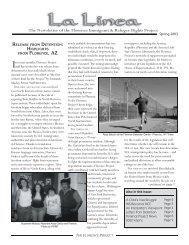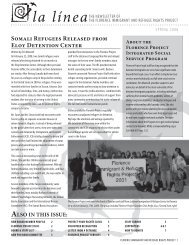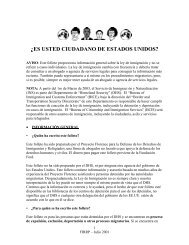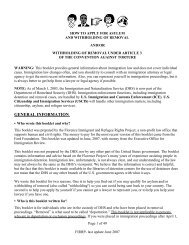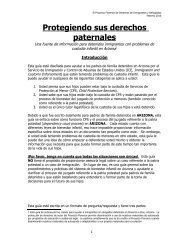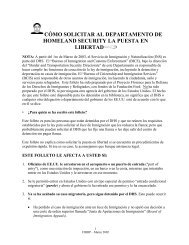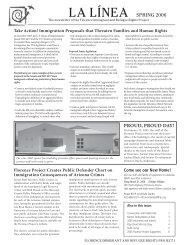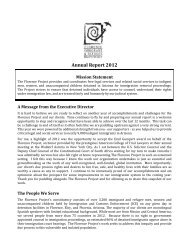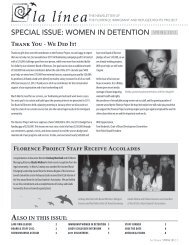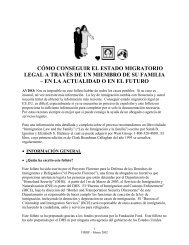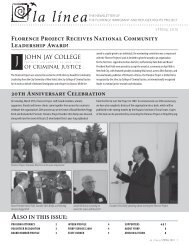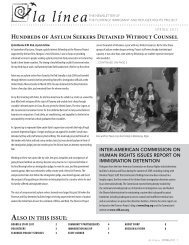quick reference chart and annotations for determining immigration ...
quick reference chart and annotations for determining immigration ...
quick reference chart and annotations for determining immigration ...
Create successful ePaper yourself
Turn your PDF publications into a flip-book with our unique Google optimized e-Paper software.
Immigrant Legal Resource Center, Florence Immigrant <strong>and</strong> Refugee Rights Project,<br />
Maricopa County Public Defender August 2012<br />
Note also that a TASC disposition in certain Arizona counties where the prosecutor rather<br />
than the court imposes counseling requirements does not constitute a conviction <strong>for</strong> <strong>immigration</strong><br />
purposes. See discussion of these options at Note: Controlled Substances.<br />
In general, where possible do not have the specific drug identified on the record. Criminal<br />
defense counsel can leave open a potential defense in <strong>immigration</strong> proceedings by creating a record of<br />
conviction that does not identify the specific dangerous (or narcotic) drug, e.g. by pleading to the<br />
language of the statute. If the record of conviction does not specifically identify what the controlled<br />
substance was, <strong>immigration</strong> authorities may not be able to establish that the substance was one of those<br />
listed as a controlled substance under federal law. Arguably “dangerous drugs” <strong>and</strong> “narcotic drugs” are<br />
terms that comprise more than controlled substances. For <strong>immigration</strong> purposes a controlled substance is<br />
defined by federal drug schedules at 21 USC §802. In Matter of Paulus the BIA held that if the state<br />
definition of controlled substance is broader than the federal definition <strong>and</strong> if the substance is not<br />
identified on the record, there is no way to prove that the substance actually was one of those on the<br />
federal list. 11 I&N Dec. 274 (BIA 1965); see also Ruiz-Vidal v. Gonzales, 473 F.3d 1072 (9th Cir.<br />
2007). There<strong>for</strong>e the conviction is not necessarily of an offense “relating to” controlled substances under<br />
the federal definition. If the offense does not involve a federal controlled substance, the conviction is not<br />
a basis <strong>for</strong> deportability, inadmissibility or aggravated felon status.<br />
Some unpublished BIA decisions have held that, even though the Arizona narcotics schedule<br />
contains drugs that do not appear on the federal schedule, the Arizona legislature “intended to” track the<br />
federal list of illegal drugs such that an Arizona drug conviction is removable regardless of whether a<br />
controlled substance is identified. See In Re: Ramon Roberto Huerta-Flores A.K.A. Roberto Huerta, :<br />
A092 444 014 - ELO, 2010 WL 5808899 (BIA Aug. 27, 2010). There<strong>for</strong>e, counsel should not assume<br />
that a controlled substance conviction with an unidentified drug will be safe.<br />
Generic solicitation under ARS § 13-1002 is a good alternate plea. For more in<strong>for</strong>mation see<br />
Note: Controlled Substances.<br />
A1. Possession or use<br />
a. Possession<br />
Crime Involving Moral Turpitude: No. The BIA reserved judgment on the question in Matter<br />
of Khourn, 21 I&N Dec. 1041 (BIA 1997), but it probably would not be so held. See also Hampton v.<br />
Wong Ging, 299 F. 289, 290 (9th Cir. 1924) (possession of opium is not a CMT).<br />
Aggravated felony: No, with the exception discussed below involving flunitrazepam. Neither a<br />
single conviction nor multiple convictions <strong>for</strong> felony possession of a controlled substance should be held<br />
an aggravated felony in <strong>immigration</strong> proceedings in the Ninth Circuit. Oliveira-Ferreira v. Ashcroft, 382<br />
F.3d 1045 (9th Cir. 2004). However, the BIA in Matter of Carachuri-Rosendo, 24 I&N Dec. 382, 386<br />
(BIA 2007) noted that Oliveira-Ferreira may be in tension with the Supreme Court’s decision in Lopez v.<br />
Gonzales, 127 S. Ct. 625 (2006), which suggests that a prior controlled substance offense that is pleaded<br />
to as part of an “enhancement” of a subsequent offense may convert the subsequent offense into an<br />
aggravated felony. There<strong>for</strong>e, counsel should avoid pleading to a controlled substance offense in which a<br />
prior drug offense is an element, is alleged or is otherwise included as an “enhancement” in the charging<br />
document or judgment.<br />
Arizona Criminal Chart with Explanatory Endnote – August 2012<br />
94



